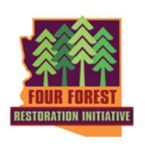 Applauding Forest Service efforts, the Four Forest Restoration Initiative stakeholders’ groups is calling the latest step toward restoring northern Arizona’s ponderosa pine ecosystem significant and historic.
Applauding Forest Service efforts, the Four Forest Restoration Initiative stakeholders’ groups is calling the latest step toward restoring northern Arizona’s ponderosa pine ecosystem significant and historic.
Currently available for public comment, the Forest Service proposal or Proposed Action for the Four Forest Restoration Initiative outlines a restoration strategy within a 750-thousand acre analysis area on the Mogollon Plateau of the Coconino and Kaibab National Forests.
Stakeholders representing community, environmental, science and industry interests have been building agreement for several years around key strategies to accelerate and fund restoration efforts that will return health to forest ecosystems, conserve biodiversity, protect communities and watersheds, safely restore natural fire regimes and create rural jobs.
“This project really is one of national significance given the unprecedented scale at which we’re working, the level of social agreement we’ve reached, and the ecological and economic benefits we expect to see through the Initiative,” said Grand Canyon Trust Director of Restoration Programs Ethan Aumack. “Carrying our momentum forward and working together to translate agreement into action through the NEPA process will be critical in ensuring that we have a plan that is ecologically, socially, and economically viable. We’re optimistic and excited to be moving forward.”
City of Flagstaff Fire Management Officer Paul Summerfelt, a member of 4FRI and the Greater Flagstaff Forests Partnership, calls the Proposed Action an important milestone, not only for our forests but for all residents and communities in northern Arizona. “Imagine a summer without destructive wildfire! All who have labored long and hard to bring this about deserve our collective thanks,” he said.
The Nature Conservancy is partnering in the 4FRI project to provide science-based guidance. “A sustainable future for Arizona requires both a healthy environment and healthy economy,” said TNC forest ecologist Edward Smith. “The 4FRI is a tremendous example of how a broad coalition of stakeholders and citizens can come together to restore the health of our forests, reduce fire risk, protect local communities and create jobs.”
Long-time ponderosa pine researcher and Ecological Restoration Institute at Northern Arizona University Executive Director Dr. Wally Covington says the condition and structure of today’s ponderosa pine forests are a far cry from what they were 150 years ago. “With thick stands of unhealthy small diameter trees crowding the landscape, our once open park-like forests are in a state of crisis susceptible to unprecedented bark beetle infestations, the drying effects of climate change and monstrously large crown fires. Using the best available science, the Forest Service is boldly taking action on a scale never before attempted to create resilient ecosystems for future generations.”
Arizona Game and Fish Department wildlife biologist Sarah Reif says forest restoration is about more than trees and fire. “Arizona wildlife thrive in forests where large patches of old and young ponderosa pine trees are separated by sunlit openings where grasses, shrubs and oak provide important food sources. This 4FRI project could help re-create and maintain these conditions for wildlife, while helping prevent large-scale habitat loss from the next Rodeo-Chediski Fire. The real benefits for wildlife boil down to the details in how thinning treatments get designed, and we look forward to rolling up our sleeves with the Forests and the public as the 4FRI planning process continues.”
The Proposed Action marks the beginning of formal Forest Service planning designed to result in a restoration plan in the form of an Environmental Impact Statement by April 2012. It can be viewed online at www.fs.usda.gov/goto/kaibab under “Documents.”
“Today’s proposal is about tomorrow’s forests,” said Center for Biological Diversity board member and senior policy advisor Todd Schulke. “It’s about leaving a legacy of forest wildlands where natural fires safely roam, native species thrive, and people are humbled and inspired to keep them so.”
The Four Forest Restoration Initiative is a nationally-recognized effort to undertake restoration within 2.4 million acres of ponderosa pine forest across the Apache-Sitgreaves, Coconino, Kaibab and Tonto National Forests. It is funded through the Collaborative Forest Landscape Restoration Program and has been endorsed by northern Arizona cities and counties, the State of Arizona, Arizona’s congressional delegation and 4FRI stakeholders.
Reflecting the Initiative’s widespread community support, Navajo County Supervisor David Tenney expressed his excitement with the release of the Proposed Action. “As county supervisor of the area most affected by the 2002 Rodeo-Chediski Fire, I embrace the Forest Service efforts to move the Four Forest Restoration Initiative forward. The Initiative represents the possibility of a brighter future without the looming threat of fire. The 4FRI is our best hope for healthier forests, safer communities and a stronger economy in northern Arizona.”
“After years of collaborative efforts, for the first time in the Southwest the Forest Service is proposing restoration at the same scale as catastrophic wildfires: hundreds of thousands of acres,” said Arizona Forest Restoration Products Inc. President and CEO Pascal Berlioux. “This is a quantum leap forward and it creates an opportunity to build an appropriate-scale small diameter wood industry as an economic engine to help pay for restoration.”
The 4FRI stakeholders meet the fourth Wednesday of each month.







